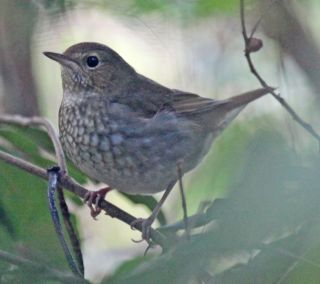Bird of the week this week, a Pygmy Wren Babbler seen skulking around Green Pigeon Path on Thursday


A new species for Po Toi, this brings the Po Toi list to 299 species. So, in keeping with tradition, I am offering a free night on Po Toi in January to the finder of number 300. If it’s a really good bird, I may include dinner at the restaurant.
Of course, I might win it myself.
Apart from that, a fairly quiet week with no weather to bring in migrants.
The number of thrushes continues to increase and I saw my first Grey-backed on Thursday (rather late) shortly after seeing my first Pale Thrush (the earliest ever for me). Also two White’s Thrushes, one behind the toilet block and one in the main area, an increasing number of Japanese Thrushes and only my second autumn Dusky Thrush, the first being on 14th November 2006. This one was a fine male but unfortunately the light quality at 6.40am on Wednesday morning defeated my rudimentary photographic skills

Blackbird numbers are falling but still common and the occasional sighting of Eyebrowed brought the thrush species total for the week to seven.
This is a good year for Daurian Redstarts, especially males which are unusually outnumbering females. Here a fine male which is quite tame and sits just inside the sisters’ café together with a Red-tailed Robin which also seem to be in good numbers this year


Japanese White-eyes have arrived in numbers and flocks are now zipping noisily around, a great contrast to the Chestnut-flanked White-eyes of three weeks ago which just quietly got on with their business. The difference in behaviour and call are quite noticeable when the species are separate but I’m not sure whether it would work for mixed flocks.
Japanese White-eye and Chinese Bulbul are winter visitors to Po Toi, see the charts I posted for Third Week in October.
Buntings were disappointing this week, just a few Black-faced and a single Chestnut on Thursday. An Asian Brown Flycatcher on Wednesday was a late bird and the Eurasian Siskins were a bit of a puzzle. Having seen only one first-winter bird last week, suddenly this week there were five on Tuesday including an adult male. I think at least two were new birds, possibly all five, but I saw none on Thursday so maybe they have gone.
Here the male Siskin plus a photo of the resident male Peregrine having a go at a passing much larger migrant bird and getting two 'high fives' in return.


And now for something completely different.
The International Space Station made a direct overhead pass at about 6.20pm on Wednesday night, a clear night, and I managed two rather shaky photographs, the first at 400mm and the second at 100mm as it moved across the sky between the Moon on the left and Jupiter on the right.
Of course, it travels in a straight line, the wobble comes from me hand-holding the camera.


The size of a football field, it’s easily the brightest object in the sky on a direct overhead pass and can be seen for about four minutes from anywhere in Hong Kong as it crosses the sky about 300 kms above your head and moving at 28,000 kms per hour. Well worth showing the kids.
You can get details of ISS passes and maps of the night sky by going to the following website and entering the co-ordinate details for Hong Kong (22.283 N, 114.15 E)
www.heavens-above.com
[
Last edited by wgeoff at 19/11/2010 06:33 ]


